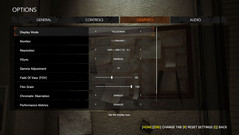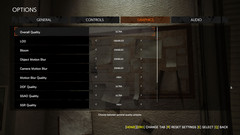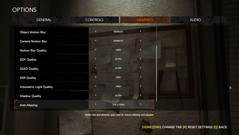The Evil Within 2 Laptop and Desktop Benchmarks
Technology
For the original German review, see here.
Unlike the first part which was released in 2014 and was technically based on "id Tech 5" by the id Software shooter expert, "The Evil Within 2" uses a slightly newer version of the engine which – fitting to the story – is called "STEM”. Even though the textures could have still been much sharper and more detailed in some places, we can attest to a decent to good quality level of the graphics overall.
In the disciplines of illumination and shadow, which are particularly important for horror games, "The Evil Within 2" convinces almost in every respect. The remaining effects such as fire and smoke are also not too bad. In addition, there are the nifty character models and an overall atmospheric look, which is created by masterful light and color accents. So the developer Tango Gameworks can be satisfied with their work.
The graphics options also give little cause for complaint. If you scroll to the bottom of the corresponding menu, you can see the access to the additional settings, which contain more than 10 different detail settings. The optional presets in particular are useful, since they adjust the overall appearance with one setting. It is also commendable that all the settings are explained as text and changing them does not require a restart. The introductory video which cannot be skipped could be very annoying. We did also become annoyed after a while that each opening of a preset menu would result in a warning message.
"The Evil Within 2" offered FXAA and TAA as anti-aliasing. Both modes smooth out diagonal edges to some extent only and provide somewhat softer looks. We did not notice any great technical problems during the test. Our only problem was that the resolution setting was often completely wrong and set too low when restarting the game, which required revisiting the graphics menu.
The performance in lower settings is also a bit strange. Even with high-end GPUs, the frame rate hardly rises in minimal and medium details. This is also related to the graphics quality hardly deteriorating when lowering the details, which is similar to other games that use the id Tech engine. You often have to look for the visual differences between the presets with a magnifying glass. You can only see larger differences in the detail level of the shadows (see screenshots below). The game uses almost 33 GB on the hard drive.
Benchmark
Since "The Evil Within 2" does not have an integrated benchmark, we had to select a representative sequence in the game play. Our final selection was the third chapter, where the gamer can move relatively freely through the small central town of Union. In order to cover the performance indoors as well as in outdoor areas, we ran from the saved point first through a building and then on the roads towards the church, in front of whose door the recording with the Fraps tool ends (see video).
The whole benchmark lasts for about 30 seconds and reflects the average performance to be expected. So it is not a worst-case-scenario, which rarely happens. While "The Evil Within 2" appears playable at 30 FPS, it really only becomes smooth from about 40 FPS.
Results
Owners of laptops without a dedicated GPU should forget about purchasing "The Evil Within 2." In the test with an Intel HD Graphics 630, there was extreme stuttering even at 1280x720 pixels and minimal details. For these settings you will need at least a model of the lower mid-range, such as the GeForce MX150.
1920x1080 pixels and the medium preset require at least a GeForce GTX 1050, and for the same resolution and the high preset we recommend at least a GeForce GTX 1050 Ti. Maximum settings only become really enjoyable with a real gaming chip (GeForce GTX 1060 and above). Anyone wanting to play on a QHD display with 2560x1440 pixels should have a GeForce GTX 1070 in their computer for higher settings, and 4K enthusiasts (3840x2160) will only be happy with a GeForce GTX 1080, if at all. The influence of the processor seems to remain very limited with all ranges of GPUs.
| The Evil Within 2 | |
| 3840x2160 Ultra Preset AA:FXAA + T 2560x1440 Ultra Preset AA:FXAA + T 1920x1080 Ultra Preset AA:FXAA + T 1920x1080 High Preset AA:FXAA + T 1920x1080 Medium Preset AA:FXAA + T 1280x720 Low Preset AA:T | |
| NVIDIA GeForce GTX 1080 Ti (Desktop), 4790K | |
| NVIDIA GeForce GTX 1080 (Desktop), 6700K | |
| NVIDIA GeForce GTX 1080 Mobile, i7-7820HK | |
| NVIDIA GeForce GTX 1070 (Desktop), 6700K | |
| NVIDIA GeForce GTX 1070 Mobile, 6820HK | |
| NVIDIA GeForce GTX 980, 6700K | |
| NVIDIA GeForce GTX 1060 (Desktop), 6700K | |
| NVIDIA GeForce GTX 1060 Mobile, 6820HK | |
| NVIDIA GeForce GTX 1050 Ti Mobile, i7-7700HQ | |
| NVIDIA GeForce GTX 965M, 6700HQ | |
| NVIDIA GeForce GTX 1050 Mobile, i7-7700HQ | |
| NVIDIA GeForce GTX 950M, 6700HQ | |
| NVIDIA GeForce MX150, i7-7700HQ | |
| NVIDIA GeForce 940MX, 6700HQ | |
| NVIDIA GeForce 940M, 5700HQ | |
| Intel HD Graphics 630, i7-7700HQ | |
| NVIDIA GeForce 920M, 2970M | |
Overview
Test Systems
| Device | Graphics Card | Processor | RAM | Operating System |
|---|---|---|---|---|
| Desktop-PC I | MSI GeForce GTX 1080 (8 GB GDDR5X) MSI GeForce GTX 1070 (8 GB GDDR5) Nvidia GeForce GTX 1060 (6 GB GDDR5) Nvidia GeForce GTX 980 (4 GB GDDR5) |
Intel Core i7-6700K | 2 x 8 GB DDR4 | Windows 10 64 Bit |
| Desktop-PC II | Nvidia GeForce GTX 1080 Ti (11 GB GDDR5X) Asus GeForce GTX 980 Ti (6 GB GDDR5) XFX Radeon R9 Fury (4 GB HBM) Sapphire Radeon R9 290X (4 GB GDDR5) Sapphire Radeon R9 280X (3 GB GDDR5) MSI Radeon R7 370 (2 GB GDDR5) |
Intel Core i7-4790K | 2 x 4 GB DDR3 | Windows 10 64 Bit |
| Alienware 17 R4 | Nvidia GeForce GTX 1080 (8 GB GDDR5X) | Intel Core i7-7820HK | 2 x 16 GB DDR4 | Windows 10 64 Bit |
| Asus G752VS | Nvidia GeForce GTX 1070 (8 GB GDDR5) | Intel Core i7-6820HK | 2 x 16 GB DDR4 | Windows 10 64 Bit |
| MSI GT62VR | Nvidia GeForce GTX 1060 (6 GB GDDR5) | Intel Core i7-6820HK | 4 x 8 GB DDR4 | Windows 10 64 Bit |
| MSI GE72 | Nvidia GeForce GTX 1050 Ti (4 GB GDDR5) | Intel Core i7-7700HQ | 2 x 4 GB DDR4 | Windows 10 64 Bit |
| Asus GL753VD | Nvidia GeForce GTX 1050 (4 GB GDDR5) | Intel Core i7-7700HQ | 2 x 8 GB DDR4 | Windows 10 64 Bit |
| MSI GL62 | Nvidia GeForce GTX 1050 (2 GB GDDR5) | Intel Core i7-7700HQ | 2 x 4 GB DDR4 | Windows 10 64 Bit |
| MSI GE72 | Nvidia GeForce GTX 965M (2 GB GDDR5) | Intel Core i7-6700HQ | 1 x 8 GB DDR4 | Windows 10 64 Bit |
| MSI PE60 | Nvidia GeForce GTX 950M (2 GB GDDR5) | Intel Core i7-6700HQ | 2 x 4 GB DDR4 | Windows 10 64 Bit |
| MSI PL62 | Nvidia GeForce MX150 (2 GB GDDR5) | Intel Core i7-7700HQ | 2 x 8 GB DDR4 | Windows 10 64 Bit |
| MSI CX72 | Nvidia GeForce 940MX (2 GB DDR3) | Intel Core i7-6700HQ | 2 x 8 GB DDR4 | Windows 10 64 Bit |
| MSI GP62 | Nvidia GeForce 940M (2 GB DDR3) | Intel Core i7-5700HQ | 1 x 8 GB DDR3 | Windows 10 64 Bit |
| MSI CX61 | Nvidia GeForce 920M (2 GB DDR3) | Intel Celeron 2970M | 1 x 8 GB DDR3 | Windows 10 64 Bit |
| Asus N551ZU | AMD Radeon R9 M280X (4 GB GDDR5) | AMD FX-7600P | 2 x 4 GB DDR3 | Windows 10 64 Bit |
| 4K Monitor | Nvidia Driver | AMD Driver |
|---|---|---|
| 2 x Asus PB287Q, Philips 328P6VJEB | ForceWare 387.92 | Crimson 17.10.1 |




































